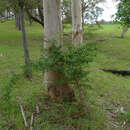Comments
provided by eFloras
This species is widespread and variable The binomial has often been ascribed to Kudô & Masamune (Ann. Rep. Taihoku Bot. Gard. 2: 27. 1932.) but they mentioned only var. gerontogea and thus did not validate any new name as they ascribed the variety to a then non-existent binomial. The identity of Cudrania chinensis Loureiro, published simultaneously with Maclura cochinchinensis Loureiro, is uncertain as no type material has been found, but the most likely possibility is that it is a spineless form of this species.
- license
- cc-by-nc-sa-3.0
- copyright
- Missouri Botanical Garden, 4344 Shaw Boulevard, St. Louis, MO, 63110 USA
Description
provided by eFloras
Shrubs, erect or scandent. Branches glabrous; spines curved or straight, to ca. 2 cm, sometimes very inconspicuous. Petiole ca. 1 cm; leaf blade elliptic-lanceolate to oblong, 3-8 × 2-2.5 cm, papery to leathery, glabrous, base cuneate, margin entire, apex rounded to shortly acuminate; secondary veins 7-10 on each side of midvein, tertiary veins reticulate. Male inflorescences a capitulum, 6-10 mm in diam., pedunculate. Female inflorescences pubescent; peduncle to 1 cm. Male flowers: calyx lobes 4, unequal; anthers short; pistillode pyramidal or shield-shaped. Female flowers: calyx lobes free or basally connate, apex thick. Fruiting syncarp reddish orange when mature, 2-5 cm in diam., pubescent. Drupes brown when mature, ovoid, smooth. Fl. Apr-May, fr. Jun-Jul.
- license
- cc-by-nc-sa-3.0
- copyright
- Missouri Botanical Garden, 4344 Shaw Boulevard, St. Louis, MO, 63110 USA
Distribution
provided by eFloras
Himalaya (Garhwal to NEFA), India, S. China, Indo-China, Malaysia, Australasia.
- license
- cc-by-nc-sa-3.0
- copyright
- Missouri Botanical Garden, 4344 Shaw Boulevard, St. Louis, MO, 63110 USA
Elevation Range
provided by eFloras
600-1200 m
- license
- cc-by-nc-sa-3.0
- copyright
- Missouri Botanical Garden, 4344 Shaw Boulevard, St. Louis, MO, 63110 USA
Habitat & Distribution
provided by eFloras
Near villages. Anhui, Fujian, Guangdong, Guangxi, Guizhou, Hainan, Hubei, Hunan, Jiangxi, Sichuan, Taiwan, SE Xizang, Yunnan, Zhejiang [Bhutan, India, Indochina, Japan, Malaysia, Myanmar, Nepal, Philippines, Sikkim, Sri Lanka, Thailand, Vietnam; Australia, Pacific Islands].
- license
- cc-by-nc-sa-3.0
- copyright
- Missouri Botanical Garden, 4344 Shaw Boulevard, St. Louis, MO, 63110 USA
Synonym
provided by eFloras
Vanieria cochinchinensis Loureiro, Fl. Cochinch. 2: 564. 1790; Cudrania cochinchinensis (Loureiro) Kudô & Masamune; C. integra F. T. Wang & T. Tang; C. javanensis Trécul; C. obovata Trécul; C. rectispina Hance; Maclura gerontogea Siebold & Zuccarini; Trophis spinosa Roxburgh ex Willdenow; Vanieria cochinchinensis var. gerontogea (Siebold & Zuccarini) Nakai.
- license
- cc-by-nc-sa-3.0
- copyright
- Missouri Botanical Garden, 4344 Shaw Boulevard, St. Louis, MO, 63110 USA
Maclura cochinchinensis
provided by wikipedia EN
- license
- cc-by-sa-3.0
- copyright
- Wikipedia authors and editors
Maclura cochinchinensis: Brief Summary
provided by wikipedia EN
Maclura cochinchinensis, commonly known as cockspur thorn, is a species of vine or scrambling shrub in the family Moraceae. The native range extends from China, through Malesia and into Queensland and northern New South Wales. The species inhabits various types of tropical forest: most commonly in monsoon forests. The globular, yellow or orange fruit are sweet and edible and were a traditional food source for Australian Aborigines.
- license
- cc-by-sa-3.0
- copyright
- Wikipedia authors and editors

